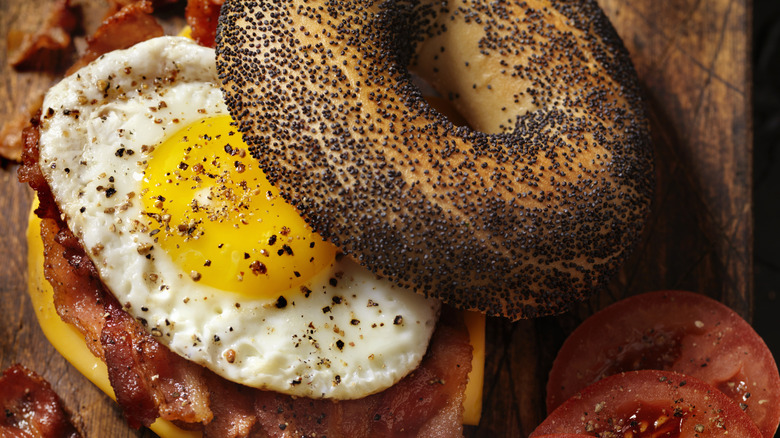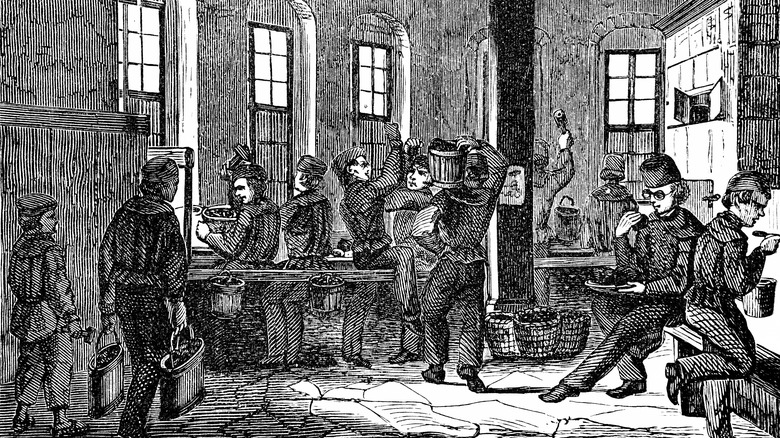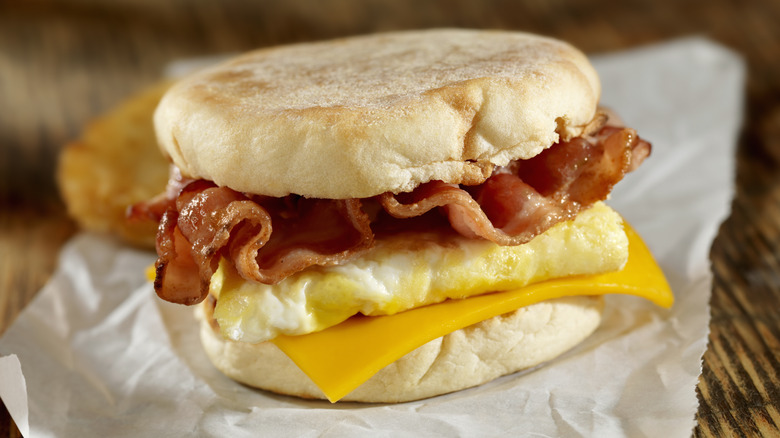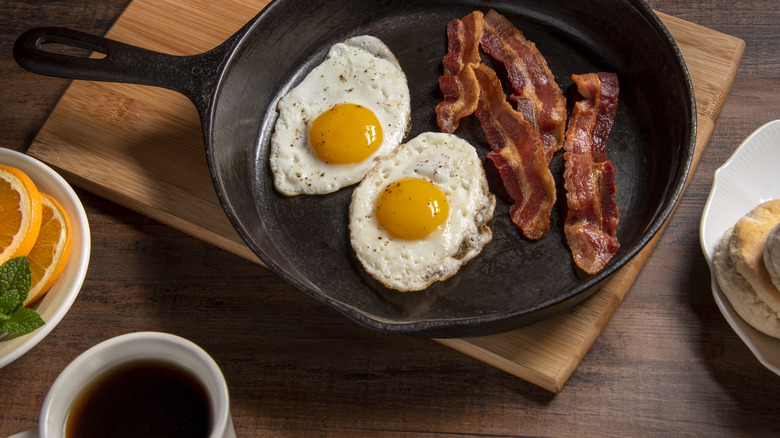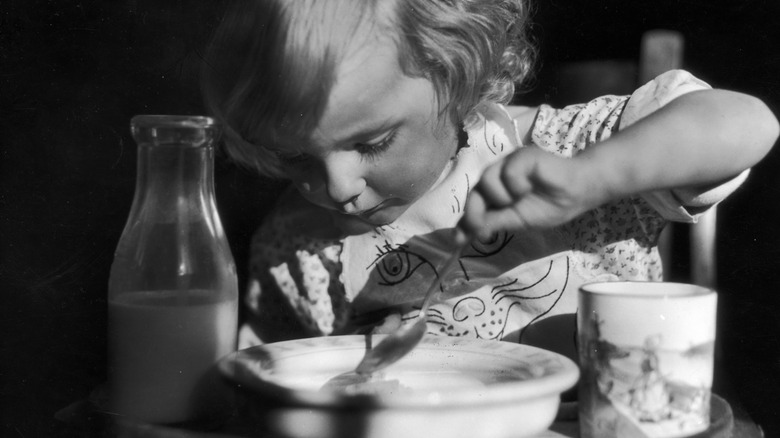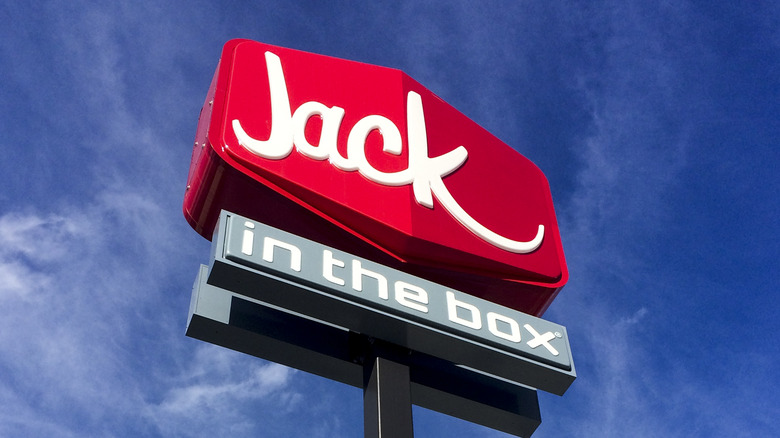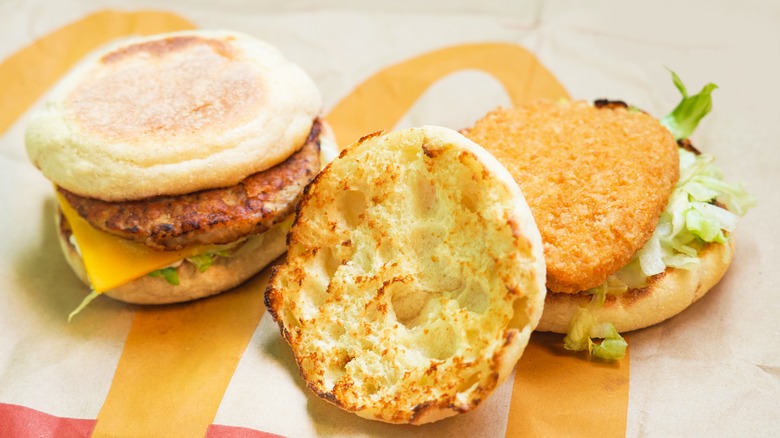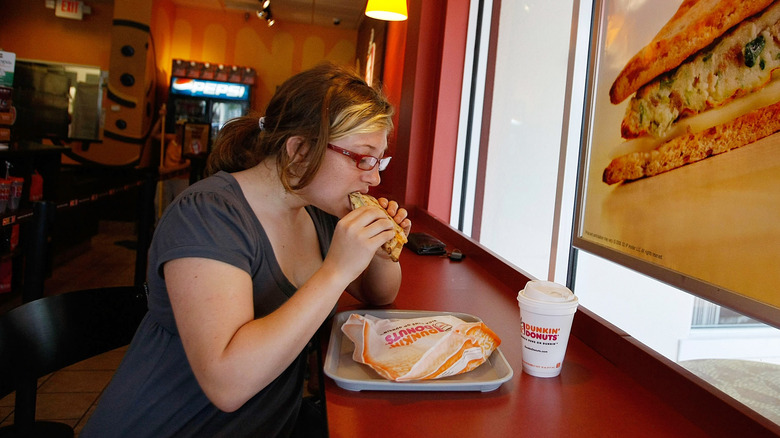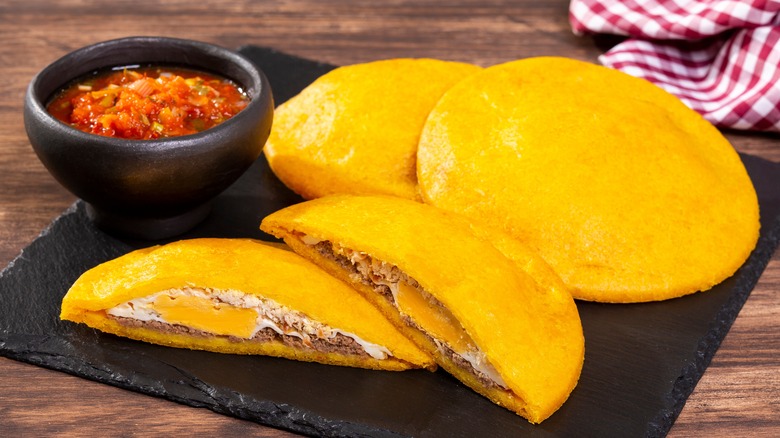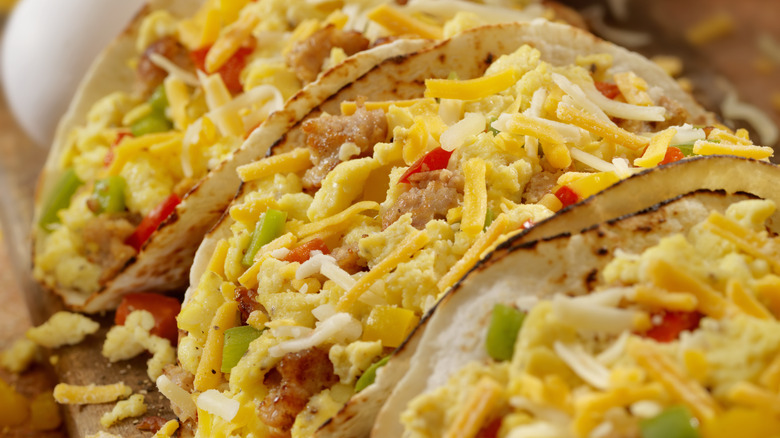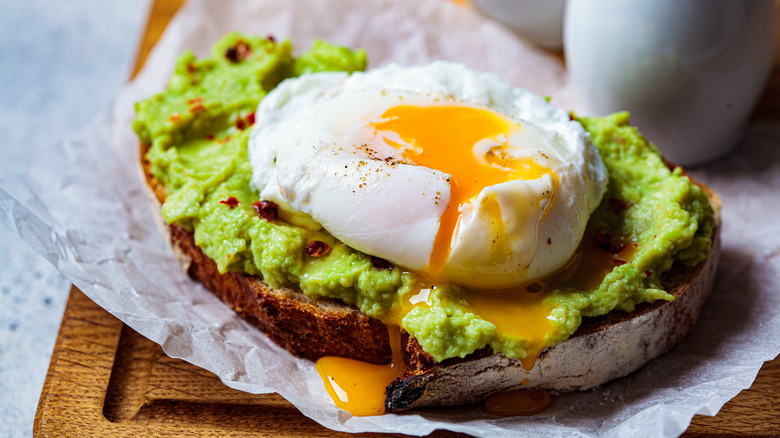The Industrial Origins Of The Classic Bacon, Egg, And Cheese Sandwich
They say that breakfast is the most important meal of the day, and data shows that many Americans choose to start their mornings with a delicious breakfast sandwich. Findings from a OnePoll study performed with the support of Sabra reveal that 46% of Americans say that they like to eat breakfast sandwiches in the morning (via Fox). In other words, this delightful dish seems to be as popular as ever.
In its most basic form, the breakfast sandwich consists of some combination of eggs, cheese, and carbohydrates. However, there are plenty of different variations out there. Meat often pairs beautifully with this classic dish, and many breakfast sandwiches come with a layer of bacon, ham, sausage, or even turkey. And, while some people like to eat their sandwiches on good old-fashioned toast, others prefer their eggs tucked into a flaky croissant or even a classic New York "everything" bagel.
From that perspective, it may seem that there are infinite versions of the breakfast sandwich on the market. But, there is a reason for this variety. According to HuffPost, breakfast sandwiches were originally popularized to satisfy the morning cravings of the budding, industrial workforce back in the 1800s. During this time, workers from Britain and the United States relied on this convenient, tasty meal. As the economy changed, people from different regions adapted the original breakfast sandwich to serve their new needs.
It is hard to pinpoint the exact origin of the breakfast sandwich
Humans have been eating breakfast for hundreds of years. However, the meal is not as universal as many would think. Many ancient Romans, for example, believed that breakfast was bad for them. Priceonomics explains they largely preferred to save room in their stomachs for just one big daily meal. Likewise, Native American tribes avoided fixed eating schedules, opting instead to graze on smaller meals throughout the day. In medieval Europe, people's relationship to breakfast was more mixed, as some people are believed to have indulged in this meal, while others likely lacked the resources to eat as soon as they woke up. Thus, many early Europeans considered breakfast a luxury experience intended only for the rich.
Despite the dubious origins of breakfast itself, the folks who did enjoy a hot morning meal often weren't too picky about what they ate. Many managed to whip something up using whatever ingredients they had lying around. Since eggs, bread, and leftover meats would have been common items in an early European household, it is likely that some version of the modern breakfast sandwich was created hundreds of years ago. That being said, home cooks would have also created mash-ups of ingredients like cheese, porridge, and even ale. Consequently, these Europeans would not have necessarily thought of their egg and bread creations as "breakfast sandwiches," instead considering them a typical re-purposing of leftover ingredients.
During the Industrial Revolution, breakfast sandwiches took off
The Industrial Revolution changed the concept of labor for thousands of people, who left their farming communities and headed to big cities to work in factories. During this time, people started having to eat around their demanding new work schedules. Many laborers were expected at the factories early in the morning.
Because of these changing dynamics, the idea of a quick meal to be consumed on the fly appealed to a lot of workers. Indeed, for the first time, laborers were expected to spend hours at a time working on the factory floors without a break. Consequently, small breakfast stands began popping up all over London, selling small egg-stuffed rolls to hungry workers. Dubbed "bap sandwiches," these early breakfast creations often included scraps of fatty, inexpensive meat, making them gooey and greasy. They were almost always served to-go, although the workers would often pause at the breakfast carts to take turns sipping coffee out of one of the establishments' many communal mugs, per The Bulletin. (The British Food Safety Act would not be passed until 1990).
The convenience of the food carts worked well for laborers. The combination of eggs and meat was ideal for workers, who needed affordable, calorie-rich meals to fuel them for hours. Meanwhile, the bread element of the sandwiches was helpful for folks who needed to be able to carry their breakfasts with them to the factories, plus it soaked up runny yolks and grease from the meat.
Breakfast sandwiches took over the American railroads
Not long after "bap" sandwiches exploded in industrial Britain, they came to the United States. And, just like in London, breakfast sandwiches in the U.S. were most popular among laborers. During the Industrial Revolution, the American train industry was taking off. A report from the Library of Congress shows that U.S.-based railroad companies laid 170,000 miles of track between 1871 and 1900. This massive project required a large number of manual laborers, and those laborers required breakfast.
According to The Bulletin, many railroad workers started their morning with an egg sandwich served in wax paper. Interestingly, as a large percentage of these laborers were originally from China, the Western version of the breakfast sandwich took on a unique twist. According to legend, Chinese cooks began to prepare the eggs into an omelet before serving them on bread. Oftentimes, they would even mix some veggies into their creations.
Apparently, this technique was inspired by the Chinese dish, egg foo young — an omelet-like plate that involves plenty of sprouts and green onions. The result, which was fondly named "The Denver Sandwich" became the first truly American version of the British bap sandwich. Over time, this treat grew popular with folks other than the railroad workers. Many settlers heading west on the Oregon Trail also came to enjoy this unique sandwich.
Americans started eating more eggs and bacon for breakfast in the 1920s
Following the beginning of the Industrial Revolution, workers continued to eat breakfast sandwiches to satisfy their morning cravings. However, it wasn't until the 1920s that Americans with other types of jobs ditched other breakfast classics, like porridge, to indulge on a big plate of eggs and bacon.
According to some historians, this transition took place as breakfast became more ingrained in the American cultural imagination. People began to see breakfast as an integral part of their day, and so they tried to make it as big and important of a meal as lunch or dinner. As food specialist, Lowell Dawson, wrote, "Americans wanted meat, meat, meat. And potatoes. And cake and pie" (via The Bulletin). And, interestingly, these cravings seemed to be supported by physicians. As revealed in a piece in Friday Sock Co., public relations guru, Edward Bernays, published a promotional piece in newspapers across the country, alleging that 4,500 doctors recommended that their patients start their day with a big plate of bacon and eggs. Thus, Americans began eating this classic breakfast combination, as they believed it to be healthier.
Of course, just because Americans in the 1920s started eating eggs for breakfast does not mean that they immediately began whipping up breakfast sandwiches. However, this turn towards eggs and bacon normalized these ingredients as elements of the morning meal, paving the way for the breakfast sandwich to eventually gain even more popularity.
After WWII, breakfast sandwiches exploded in popularity
Following the second World War, Americans, in particular, were all about convenience. Morning food items, like instant coffee and Pop-tarts, hit the market and quickly gained popularity. Similarly, breakfast sandwiches became more widespread than ever before — due to their easily-consumable shape. Unlike the classic bacon, eggs, and toast combo, breakfast sandwiches were compact. As an added bonus, they could be carried around and eaten on the go. This appealed to Americans, who were already starting to drift away from old-fashioned sit-down meals.
Convenience stores became one of the primary places to purchase these sandwiches. Folks would swing by these local shops on their way to work and consume their breakfasts either at the counter or in their cars on the way to work.
Naturally, though, breakfast sandwich recipes began to vary from locale to locale. While some people added veggies, like tomatoes, to their breakfast sandwiches, others preferred to switch up the meats, trading in bacon for ingredients like ham and sausage. These distinctions were even more pronounced from region to region. In the South, many people would serve their egg sandwiches on biscuits, while New Yorkers preferred to order theirs on a bagel. The Denver Sandwich also maintained its popularity, although newer versions were likely made with a wider variety of veggies.
Fast food restaurants became popular in the 1950s and 1960s
As Americans began to crave convenience, road travel became more popular. By the 1950s and 1960s, many American families were able to invest in cars, which they used to navigate the ever-growing U.S. highway system. As investigative journalist, Adam Chandler, revealed in an interview with Smithsonian Magazine, fast food "was a natural business response to the American on-the-go kind of lifestyle."
In order to sells meals to Americans on the run, fast food restaurants started popping up across the country. These businesses flourished by serving inexpensive and relatively low-quality eats at a lightning speed pace. This allowed Americans to eat lunch and dinner the way that they had already been consuming breakfast — in a compact bun which could be easily transported with them.
As a result, it was hardly astonishing when California-based fast food chain, Jack In The Box, launched the first fast food breakfast sandwich sometime between 1969 and 1971. This OG product sold egg, cheese, and meat wedged between two halves of an English muffin. This fast food sandwich quickly became popular. Americans no longer had to stop in their local convenience stores to pick up breakfast. Instead, they could swing by their local fast food joints and grab a hot bun to go. This was also a huge win for Jack in The Box, financially-speaking. The sandwich allowed the chain to sell inexpensive ingredients, like eggs and bread, with fantastic margins.
McDonalds launched the Egg McMuffin
The creation of the fast-food breakfast sandwich was a big deal in and of itself. However, this new type of breakfast bun did not become universal until the McDonald's egg McMuffin was born. According to some, this dish was the brainchild of franchise owner, Herb Peterson. As a huge fan of the classic Eggs Benedict, Peterson wanted to come up with a fast-food version of his long-time favorite. Hence, he decided to eliminate messy Hollandaise sauce from the recipe and transform the dish into a more transportable breakfast sandwich.
Once Peterson perfected his recipe, he decided to share it with Ray Kroc, who then was working as the president of McDonald's. When Kroc traveled to California on an unrelated visit, Peterson saw an opportunity to serve him this fascinating idea. He approached the president with an original Egg McMuffin and asked him to taste it. Kroc was not originally too interested in the concept. Nonetheless, he tried the Egg McMuffin out of politeness. Later, the company president wrote, "He didn't want me to reject it out of hand, which I might have done, because it was a crazy idea — a breakfast sandwich ... I boggled a bit at the presentation. But then I tasted it, and I was sold" (via The Bulletin). Luckily, Americans loved Peterson's idea just as much as Kroc did. Per The Bulletin, the Egg McMuffin became an immediate hit, comprising a quarter of the company's total sales.
Restaurants began serving breakfast all day
For many years, the breakfast sandwich was considered, well, a breakfast item. However, as businesses noticed just how popular this meal was, they began offering it throughout the day. One such business was McDonald's, which initially stopped serving the Egg McMuffin after 10:30 am. However, due to popular demand, the restaurant began offering the breakfast sandwich during the afternoon hours, as well. As the chain's US president, Mike Andres, shared in an interview with the Wall Street Journal, "This is the consumers' idea. This is what they want us to do."
Naturally, McDonald's is far from being the only U.S.-based restaurant to serve breakfast all day. All kinds of restaurants – including bodegas and delis – continue selling the bacon egg and cheese sandwich during lunch hours. Many even serve them as a late night snack. In a piece for Bon Appétit, food writer Mike Duckor applauded the day-long availability of this treat, writing, "Growing up, breakfast for dinner [...] was something to look forward to." He later added, "Every time I bite into a bodega breakfast creation after 4 p.m., it takes me back." Indeed, bodega bacon and egg sandwiches aren't only a great start to a weekend morning — they can also satisfy late-night cravings.
American fast-food restaurants created new breakfast sandwiches for international audiences
Although the breakfast sandwich originally hailed from England, people all over the world continue to enjoy this versatile dish. In recent decades, fast food restaurants, like Mcdonald's, have grown increasingly international. As these companies have expanded, they have brought the breakfast sandwich around the world with them.
In New Zealand, this trend has manifested itself in the form of the Massive McMuffin — a tall stack of breakfast ingredients that includes two sausage patties, one egg, a layer of bacon, and a piece of cheddar cheese. And while this treat is popular among Kiwis, it is not the only transportable breakfast item in the Land of the Long White Cloud. Indeed, McDonald's New Zealand also offers an adaptation of the breakfast sandwich that is packaged into a classic Kiwi-style pie. Dubbed the Georgie Pie Bacon 'N' Egg, this dish packs traditional eggs and bacon into a crispy fast-food pastry crust.
Interestingly, however, some international versions of the breakfast sandwich do not include ingredients that Americans associate with breakfast. In a few Middle Eastern countries for example, McDonald's sells a breakfast sandwich called the Halloumi Muffin. This meatless sandwich combines a thick piece of Halloumi cheese with fresh herbs and a thin layer of olive paste to create a sandwich that's balanced and flavorful. What's more, it focuses on ingredients that are commonly consumed for breakfast in the Middle East, rather than on American favorites.
American immigrant communities invented new breakfast sandwiches
Over the years, immigrants from all over the world have come to the United States, and, luckily, many of them have made incredible contributions to the classic breakfast sandwich. For example, at the Taiwanese-American Win Son Bakery, in New York City, patrons can enjoy a unique interpretation of the traditional sandwich. Rather than serving bacon, eggs, and cheese on a NYC bagel, this locale wedges these ingredients into a Taiwanese scallion pancake. This combination of savory scallions, flaky dough, and hot filling makes for an incredibly mouthwatering morning meal.
Interestingly, this is far from being the only breakfast sandwich variation in the United States. Moises Bakery in Miami is a Venezuelan-owned locale that sells breakfast sandwiches with a South American twist. In place of bread, this locale serves egg stuffed inside arepas, allowing its patrons to experience classic morning flavors served in hot Venezuelan Dough. In a similar spirit, the R House Wynwood offers a Cuban breakfast croissant for their weekend brunches. Served on a flaky pastry, this combination of eggs, Serrano ham, swiss cheese and mojo pork brings all the savory meatiness of the Cuban sandwich to breakfast time.
The breakfast taco was popularized
Of all the more recent contributions to the American breakfast sandwich scene, the breakfast taco might be the most well-known. Legend has it that this delicious dish was first popularized in Austin, Texas via the classic local eatery, the Tamale House. The restaurant's original founder, Anthony Vasquez, wanted to open the locale to serve his wife's fantastic breakfast special — a combination of eggs, cheese, and homemade taco shells. However, back in the 1980s, Vasquez was concerned that white Texans would not be interested in enjoying this delightful type of Tex-Mex.
Luckily, Vasquez changed his mind on a trip to California, where he noticed people of various different backgrounds buying tacos from simple food stands. Inspired by what he saw in the Golden State, Vasquez returned to Texas, opened the Tamale House, and started selling breakfast tacos. The concept took off from there. Vasquez's daughter, Diana Vasquez-Valera, told Eater, "Breakfast tacos began when they were sold to the public, and they became — not an overnight sensation, but a novelty, a delicioso concept."
As the years went on, breakfast tacos exploded in popularity. These days, they are considered a dish in their own right. And, one can find them all over the country — from Florida to Oregon. As food journalist, Robb Walsh, told Eater, "the word went out, and in Brooklyn and LA, you can get Austin-style breakfast tacos."
The rise of healthy breakfast sandwiches
Although the traditional bacon, egg, and cheese breakfast sandwich remains delicious it isn't particularly healthy. Registered dietician Holly Klamer told Everyday Health, "Breakfast sandwiches are notorious for not being a healthy food. They tend to be high in calories and saturated fat and low in fiber." Iterations smothered in mayo and other condiments also aren't ideal. In order to enjoy healthier versions of this popular dish, many Americans have started preparing breakfast sandwiches with more nutritional elements, like wheat bread and sautéed veggies.
One of the most popular versions of the newer, healthier breakfast sandwich is avocado toast. This unique type of open-faced sandwich involves spreading mashed avocado over a piece of warm bread and topping it all with a poached egg. Popularized in 2010, the dish can attribute its fame to a rise in healthy eating. As food writer, Christine Muhlke, wrote in her book, "Signature Dishes That Matter" (via Mashed), "Within a few short years, variations on this virtuous-seeming yet indulgent (and Instagrammable) dish made it the symbol of the wellness movement."
